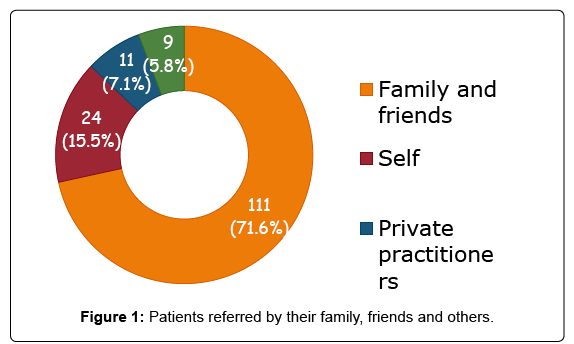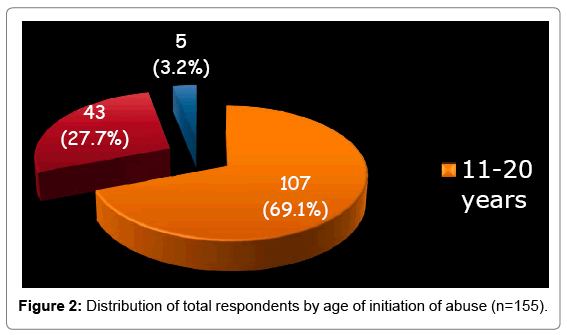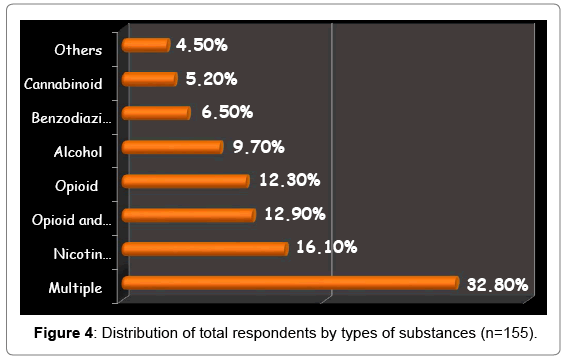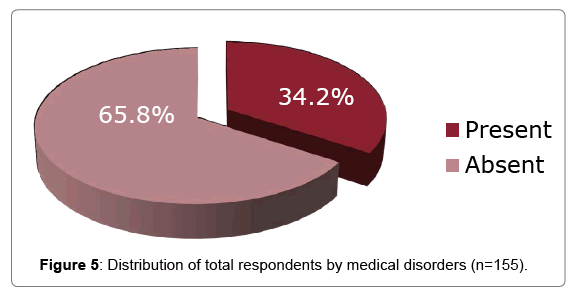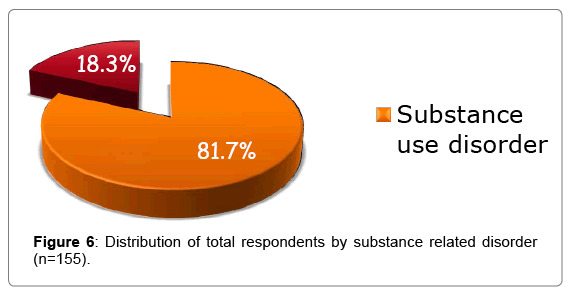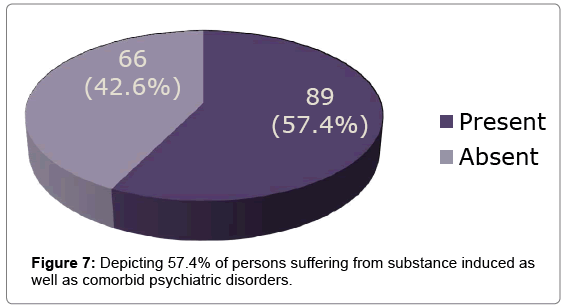Socio-Demographic and Clinical Profile of Substance Abusers Attending a Regional Psychiatric Hospital in Sylhet, Bangladesh
Received: 22-Jul-2017 / Accepted Date: 07-Sep-2017 / Published Date: 14-Sep-2017 DOI: 10.4172/2155-6105.1000342
Abstract
This was a cross sectional and descriptive study. It was conducted in a private psychiatric hospital in Sylhet, Bangladesh; duration was one year from 01/04/2014 to 31/03/2015. Study populations are all substance abuser patients, admitted in that hospital that fulfilled the inclusion and exclusion criteria. After consecutive sampling, 155 substance abuser patients were interviewed in a peaceful and non-threatening environment. Patients have been interviewed using questionnaire. Psychiatric disorders were assessed by using DSM-V criteria. This study revealed that, out of 155 patients, 101 (65.2%) was below age of 30 years. The mean age of the patients was 25.9 years (SD 7.61). Among all patients 147 (94.8) were male and 8 (5.2%) were female. Among all respondents 69.1% had history of initiation of abuse in between age of 11 to 20 years. Among them 34.2% patients had been suffering from medical disorders. 57.4% had been suffering from substance induced as well as co morbid psychiatric disorders. The commonest co morbid psychiatric disorders in our population were major depressive disorder (18.1%). Most of our cases came from urban localities (71.6%), which may be a reflection of the increase in urbanization in our country. The educational level of major portion of respondents was at least up to higher secondary level. It may be due to some sorts of increased facilities of education in Bangladesh now days as well as most of the patients came from solvent family.
Keywords: Psychiatric disorders; Public health; Substance abuse; Socio-demographic variables
Introduction
Substance abuse is one of the major public health issues throughout the world. The menace of substance abuse is a matter of great concerns not only for its social and economic consequence but also for its association with psychiatric and physical morbidities. The problem is not merely that of an individual or a community, and a substance, but involves interaction between the triad [1]. The multiplicity of factors associated with substance abuse and their inter-relatedness makes the problem a complex one [2]. Knowledge of the trends and patterns of drug abuse is very important to formulate effective and appropriate interventions that need to be delivered in countries facing substance abuse problems.
Rationale
The relationship between substance abuse with co morbid physical and psychiatric disorders have not been commonly addressed, though these group of patients are frequently encountered in clinical practice in our country. As there was no such study in north east region of our country it seemed to be worth-investigating. The outcome could be treated as additional information to the existing other studies in countrywide. Moreover this wealth of data will be the source for future research.
Objectives
• To find out substance related disorders among the substance abuser patients.
• To find out co morbid psychiatric disorders.
• To find out specific types of co morbid psychiatric disorders.
• To find out the physical illness among the substance abuser patients.
• To find out the socio-demographic variables among the substance abuser patients.
Materials and Method
Type of study
• This was a cross sectional and descriptive study.
Place of the study
• Study was conducted in a private psychiatric hospital in Sylhet, Bangladesh.
Study population
• All substance abuser patients, admitted in a psychiatric Hospital, in Sylhet, were included as a study population.
Sample
• The sample of the study comprised 155 Substance abuser patients who fulfilled the inclusion and exclusion criteria.
Sample size: 155
Sampling technique: Consecutive convenient sampling.
Duration of the study: One year from 1st April 2014 to 31st March 2015 (Chart 1).
Inclusion criteria
• All substance abuser patients irrespective of age and sex groups.
Exclusion criteria
• Patients with cognitive impairment.
• Mute, stupor, unresponsive and non-co-operative patients.
• Patients who didn’t give consent.
Research instruments
• Structured questionnaire for socio-demographic and other information which was fix response type.
• DSM-V criteria for diagnosis of psychiatric disorders.
Variables
Age, Sex, Religion, Occupation, Education, Marital status, Social background, Socioeconomic status, Paths of referral, Age of initiation of substances, Reasons of substance abuse, Types of substances, Medical disorders, Psychiatric disorders.
Methodology and Data Collection
After consecutive sampling, 155 substance abuser patients were interviewed in a peaceful and non-threatening environment. Patients have been interviewed using questionnaire. Psychiatric disorders were assessed by using DSM-V criteria.
Flow chart for data collection.
Preparation of the questionnaire
Statistical Analysis
After collecting data, editing was done manually and data were analyzed with the help of computer software program SPSS version 17.0 (Statistical package for social science). Descriptive statistics was presented in frequencies and percentages.
Ethical Issues
Informed written consent (Bengali version) was taken from each patient as well as legal guardians. There was no chance of any physical adverse effect as no intervention was done. All sorts of confidentiality were ensured.
Results
This study revealed that, out of 155 patients, 101 (65.2%) was below age of 30 years (Table 1). The mean age of the patients was 25.9 years (SD 7.61) (Table 2). Among all patients 147 (94.8%) were male and 8 (5.2%) were female. Out of 155 patients 71.6% were referred by their family and friends (Figure 1). Among afll respondents 69.1% had history of initiation of abuse in between age of 11 to 20 years (Figure 2). Out of 155 patients 96 (61.8%) abused more than one substances and 32.8% abused multiple substances (Figure 3). Among them 34.2% patients had been suffering from medical disorders (Figure 4). Among all respondents 81.7% had been suffering from substance use disorder (Figures 5-7). The commonest co morbid psychiatric disorder in our population was major depressive disorder (18.1 %) (Tables 3 and 4).
| Age | Sex | Total | |
|---|---|---|---|
| 11-20 years | 16 (10.3%) | 0 (0%) | 16 (10.3%) |
| 21-30 years | 79 (50.9%) | 6 (3.9%) | 85 (54.8%) |
| 31-40 years | 38 (24.5%) | 2 (1.3%) | 40 (25.8%) |
| 41-50 years | 4 (2.6%) | 0 (0%) | 10 (6.5%) |
| >50 years | 147(94.8%) | 0 (0%) | 4 (2.6%) |
| Total | 10 (6.5%) | 8(5.2%) | 155(100%) |
Table 1: Age and Gender grouping of substance abused patients (n=155).
| Characteristics | Respondents |
|---|---|
| Religion Islam Hinduism Buddhist |
133 (85.8%) 21 (13.6%) 1 (0.6%) |
| Education Illiterate Literate (Read & write) Up to Primary Up to SSC Up to HSC Graduate and above |
2 (1.3%) 18 (11.6%) 32 (20.6%) 16 (10.3%) 53 (34.2%) 34 (21.9%) |
| Marital status Unmarried Married Divorced/Separated |
80 (51.6%) 69 (44.5%) 6 (3.9%) |
| Social background Urban Rural |
111 (71.6%) 44 (28.4%) |
| Socioeconomic status < 15,000 BDT 15,000-24,000 BDT 25,000-35,000 BDT > 35,000 BDT |
17 (11.0%) 27 (17.4%) 46 (29.7%) 65 (41.9%) |
Table 2: Distribution of total respondents by socio-demographic characteristics.
| Medical disorder | Frequency | Percentage |
|---|---|---|
| Non ulcer dyspepsia | 19 | 12.2% |
| Peptic ulcer disease | 6 | 3.8% |
| Hypertension | 11 | 7.1 % |
| Diabetes mellitus | 5 | 3.2% |
| Epilepsy | 5 | 3.2% |
| COPD | 4 | 2.6% |
| CLD | 3 | 1.9% |
| No disorder | 102 | 65.8% |
| Total | 155 | 100% |
Table 3: Distribution of respondents on specific medical disorders (n=155).
| Psychaitric Disorders | Frequency | Percentage |
|---|---|---|
| Previously diagnosed psychistric disorder | 60 | 39.10% |
| Substanced induced psychiatric disorder | 29 | 18.30% |
| Total | 89 | 57.40% |
Table 4: Distribution of respondents on psychiatric disorders (n=89).
Discussion
In this study, the mean age of the patients was 25.9 years (SD 7.61) with male predominance (94.8%). This result was almost similar to a study conducted in Kashmir, India where the mean (SD) age of patients was 26.8 years (SD 7.37). In the present study most of the patients came from urban area and solvent family which were similar to the findings of some South Asian studies and different from some others study. Most of our cases came from urban localities (71.6%), which may be a reflection of the increase in urbanization in our country. One of the important factors of drug addicts is absence of parental care in modern families where both parents are working [3]. The educational level of major portion of respondents was at least up to higher secondary level. But this finding was not similar to some other earlier studies. It may be due to some sorts of increased facilities of education in Bangladesh now days as well as most of the patients came from solvent family. Worldwide there is a rising trend in the number of people who resort to substance abuse at an early age. In our study also, most of the substance users had started taking drugs in between the ages of 11 to 20 years. The commonest reasons for first use of substance in the study were peer pressure and relief from negative mood state which were similar to other studies [4]. The majority of our subjects were commonly abusing nicotine, cannabis and opioids, probably reflecting the true drug use pattern in the community. Many of the patients were brought in and attended by their relatives (71.6%), which hints to a good social support system, reflecting the traditional Bengali society. Medical disorders were present in 34.2% of cases in our study where an Indian study revealed 22% of co morbid medical disorder. This difference is may be due to difference of individuality as well as duration and pattern of substance abuse. The presence of psychiatric disorders either comorbid or substance induced was high (57.4%) in this study. Many epidemiological and clinical studies have also shown a high degree of concurrence of substance abuse and psychiatric disorders. The common psychiatric disorders found in the present study were major depressive disorder (18.1%) and conduct disorder (10.3%). These findings were differed from the findings of a study of Kashmir, India where they found predominance of Bipolar and related disorders [5-10]. But our findings were similar to another study conducted in North India.
Conclusion
This study revealed that poly-substance abuse in young adults from urban residence belonging solvent families was quite common in this area. The high proportion of psychiatric disorders among these substance abused patients is also a matter of great concern. Present findings will help to make plan for better intervention strategies and relapse prevention for substance abusers.
Limitations of the Study
Small number of patients. It was an observational study and there was no controlled group. The study was primarily based on a treatment seeking population, which is possibly different from the community where substance use is still not thought to be a disease, but only a social or legal problem.
References
- Ortiz A (1990) Development of a system for registry of information of drug use in Mexico. Bull Pan Am Health Organ 24: 46-53.
- Ray R (2006) Drug abuse monitoring system. World Health Organisation, India. National drug dependence treatment center, AIIMS. New Delhi. WHO Biennium project 2006-2007.
- Harpham T (1994) Urbanization and mental health in developing countries: A research role for social scientists, public health professionals and social psychiatrists. Soc Sci Med 39: 233-245.
- Margoob MA (2001) Intense psychosocial stress and changing pattern of psychiatric disorders over the past eleven years in Kashmir valley of Indian sub-continent. XVII world congress of world association for social psychiatry.
- Rather YH, Bashir W, Sheikh AA, Amin M, Zahgeer YA (2013) Socio-demographic and clinical profile of substance abusers attending a regional drug de-addiction centre in chronic conflict area, Kashmir, India. Malays J Med Sci 20: 31-38.
- Murthy P (2002) Women and drug abuse: The problem in India. In: Murthy P, editor. Women and drug use in India: Substance, women and high-risk assessment study. Regional office for South Asia: United Nations international drug control programme and ministry of social justice and empowerment, Government of India, pp: 5-6.
- Margoob MA, Abdul M, Arshid H, Zaid AW, Akash Y, et al. (2004) Changing socio-demographic and clinical profile of substance use disorders patients in Kashmir valley. JK Practitioner 11: 14-16.
- Venkatesan J, Stelina SD (2008) Substance dependence: Decades apart in a teaching hospital. Indian J Psychiat 50: 100-105.
- Seth R, Kotwal A, Ganguly KK (2005) Street and working children in Delhi, India, misusing toluene: An ethnographic exploration. Subst Use Misuse 40: 1659-1679.
- Waraich BK, Chavan BS, Raj L (2003) Inhalant abuse: A growing public health concern in India. Addiction 98: 1169.
Citation: Roy S (2017) Socio-Demographic and Clinical Profile of Substance Abusers Attending a Regional Psychiatric Hospital in Sylhet, Bangladesh. J Addict Res Ther 8:342. DOI: 10.4172/2155-6105.1000342
Copyright: © 2017 Roy S. This is an open-access article distributed under the terms of the Creative Commons Attribution License, which permits unrestricted use, distribution, and reproduction in any medium, provided the original author and source are credited.
Share This Article
Recommended Journals
Open Access Journals
Article Tools
Article Usage
- Total views: 5192
- [From(publication date): 0-2017 - Dec 31, 2024]
- Breakdown by view type
- HTML page views: 4479
- PDF downloads: 713


